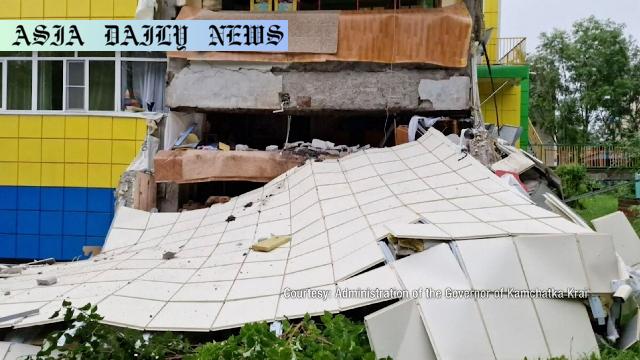Earthquake: A Kamchatka resident describes the fear and chaos caused by Wednesday’s intense earthquake and its aftershocks.
- A powerful earthquake hit Kamchatka in Russia’s Far East on Wednesday.
- A resident described the quake as intense, with the ground feeling like it was dancing for a minute.
- Tsunami waves reached 200 meters inland, causing minor damages to homes and cars.
- Residents are anxious about aftershocks, with many choosing to sleep in their cars.

The Unfolding of a Powerful Earthquake in Kamchatka
On Wednesday, a significant earthquake rocked Kamchatka, in Russia’s Far East, leaving residents in a state of fear and uncertainty. The quake was described by one resident in Petropavlovsk-Kamchatsky, the regional capital, as a harrowing experience. She narrated through a phone interview how the ground trembled violently from side to side, almost as if it were ‘dancing.’ The shaking lasted approximately a full minute—a duration that felt like an eternity to those experiencing it.
Such a strong earthquake was unprecedented for many locals, increasing the psychological impact on the affected communities. While human injuries were fortunately not reported in significant numbers, the emotional toll and anxiety were palpable. Certain residents opted to sleep in their cars rather than return indoors, deeply uneasy about the ongoing aftershocks. These aftershocks, although less intense, carried enough force to disrupt the fragile sense of safety.
The Tsunami’s Reach and Impact
The earthquake’s force triggered tsunami waves that traveled up to 200 meters inland in Severo-Kurilsk, a town on the Kuril Islands. Although major structural damage was avoided, the scene in Severo-Kurilsk depicted inundated coastal buildings and vehicles. The sight was a stark reminder of the potential devastation such seismic events carry. Reports also confirmed that interior furniture in many homes had been damaged, though the structural integrity of homes remained largely intact.
Local emergency services reinforced their presence to assist the affected population while monitoring signs of further seismic activity. For residents of such earthquake-prone regions, the event resurrected lingering fears of possible future tsunamis, reminding everyone of the necessity of being prepared for nature’s sudden wrath.
Managing the Human Emotional Impact
Beyond physical destruction, the psychological distress among Kamchatka residents was severe. Words from the interviewee emphasized the sheer terror of living through such a powerful quake, describing it as ‘the scariest experience’ of her life. With aftershocks continuing to jolt the ground, the widespread sentiment in the area was one of caution and trepidation. Families avoided returning home, instead opting for the perceived safety of their vehicles.
Authorities began implementing measures to reassure and assist the public. Emergency shelter sites and resources for safe sleeping arrangements were discussed. Additionally, information dissemination played a significant role in keeping people informed about safety precautions and upcoming weather conditions, reducing overall panic amidst a challenging situation.
Conclusion: The Lessons from Kamchatka
The Kamchatka earthquake underscores the raw power of geological activity and its ability to disrupt lives in an instant. While there was no significant destruction, the close call serves as a stark reminder of disaster preparedness importance. Residents of seismic hotspots, local authorities, and emergency services must continue to work together to develop resilient response plans to mitigate harm during future incidents.
It is crucial that such events lead to impactful discussions on improving infrastructure, emergency protocols, and mental health support systems for individuals affected by earthquakes. Learning from this incident could ensure better safety outcomes when facing nature’s unpredictability again.



Commentary
The Unforgettable Experience of Kamchatka’s Earthquake
The recent earthquake in Kamchatka has once again highlighted the unpredictable strength of natural forces that shape our planet. For the residents, this was not just a geological event but a harrowing encounter with life’s fragility. The descriptions of ‘dancing ground’ and intense fear evoke a chilling reminder of how vulnerable we are against Earth’s dynamic processes.
What resonated most was the human reaction to the quake. The decision made by many residents to sleep in their cars instead of returning home demonstrates how severely the quake impacted not just their physical safety but their sense of security. Such vulnerability reflects the profound emotional toll disasters can have, even in areas accustomed to seismic activity like Kamchatka.
Community and Preparedness Shine in Times of Strain
This calamity also draws attention to the resilience of the Kamchatka community. Despite the fear, residents and officials acted swiftly, prioritizing safety and organizing contingency plans. The presence of emergency personnel and their readiness to address post-quake challenges are testaments to the importance of preparation in regions at risk of frequent geological disturbances.
However, there remains a pressing need for more robust infrastructure and community support frameworks. Events like this should serve as a prompt to enhance disaster readiness. Additionally, fostering greater awareness and education around earthquake preparedness will undoubtedly empower residents to act confidently during future incidents.
Reflections on Disaster and Resilience
In conclusion, this earthquake is a stark reminder of nature’s unpredictability, but it also showcases humans’ incredible ability to adapt and persevere. As the people of Kamchatka rebuild their daily lives, this experience will undoubtedly serve as a stepping stone toward better emergency planning and infrastructure improvement.
For regions worldwide prone to disasters, this incident spotlights the importance of learning from one another and ensuring preparedness does not waiver. Ultimately, it is this collective resilience and preparedness that could save lives and provide hope in the aftermath of disasters.